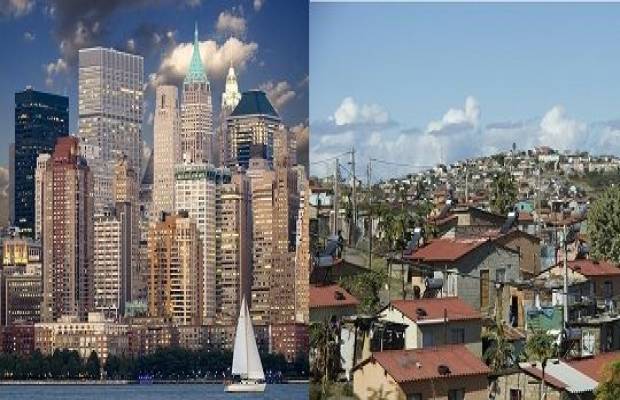Major Differences Between Developed And Developing Countries

Up until recently, a lot of specialists only used economic definitions of third-world development, such as GDP factor, wealth and income, capital accumulation, and commodity production. The political, social, and environmental aspects of growth have been scrutinised more closely throughout time, even though they are still significant.
As a result, new definitions of development are emerging that are far more inclusive and more in line with the needs of those who live in third-world nations. "Development is a whole; it is an integral, value-laden, cultural process; it encompasses the natural environment, social relations, education, production, consumption, and well-being," states The Dag Hammarskjold Foundation.
Major Differences Between Developed and Developing Countries
A nation's income is not the only factor used to classify it; other aspects that impact the living standards of its population, the degree to which its economies are connected to the global economy, and the growth and diversification of its export sectors are also taken into consideration.
However, it depends on the state of the economy, which includes factors like per capita income, industrialization, birth rates, literacy rates, and the country's reliance on international commerce, as well as the average wealth per person and the GDP of the country.
Therefore, a developed country has reached a high level of industrial development, bases its economy on manufacturing and technology rather than agriculture, fully utilises its natural and human resources for production and has a high level of per capita income as a result of increased production and consumption.
READ ALSO » Differences Between Herbivores And Carnivores
Developed countries are sovereign (independent) nations and states whose economies have advanced significantly and have excellent technological infrastructure in comparison to other nations.
Conversely, developing nations are those with low levels of industrialization and human development index. These are underdeveloped industrialised nations with low human development indices [HDIs].
Moreover, the rate of schooling in developed nations is high. One of the key components of development, education broadens people's perspectives on the world and themselves, which advances national development. Their lives are made better, and both individuals and society as a whole gain greatly from it.
Education boosts productivity and creativity, as well as entrepreneurship and technical advancements.
It is crucial for maintaining social and economic development as well as for enhancing income distribution.
Education offers a backdrop for the growth of various learner organisations as well as a means of assisting youth in learning proper interpersonal interaction patterns: Because the school classrooms consist of a diverse range of people, this offers a platform for the formation of many sorts of socially acceptable person-to-person behavioural patterns. Students from various social, ethnic, and cultural backgrounds are introduced to these sessions.
IEducationfosters social behaviours that will benefit students in adulthood and imparts knowledge beyond the requirements of the academic curriculum. Those who have received an education are likely to become influential leaders who will shape their nation's policies and practices. But emerging nations cannot claim to have a normal education, hence the people in charge of affairs are often illiterate.
READ ALSO » Top 10 Most Developed Countries In Africa 2023
The cultures of developed nations are generally more progressive than those of emerging nations.
Development is made possible by culture when initiatives leverage cultural resources and place a strong emphasis on locally produced goods, expertise, and knowledge recognise and engage with the unique characteristics of a location and community.
Regretfully, debates on culturally sanctioned killings, gender equality, and other abhorrent customs continue to persist in emerging nations. These debates should never have begun in the first place. Another issue with culture and developing nations is the fact that there is still a lack of harmony and understanding between cultures and traditions.
With significant positive effects on the social, economic, and environmental spheres, cultures, heritage, and the creative industries are potent forces for development in and of themselves. By highlighting the various and distinctive identities, customs, and cultural services and goods of a region, as well as by focusing on job creation, a community's cultural riches can be transformed into economic prosperity and a source of income.
Living conditions in developed nations are often calm, well-educated, and healthful; in contrast, emerging nations frequently lack these amenities. There are other nations that are growing quickly, which means they are creating industries and economies to rival on a worldwide scale.
However, developing nations are still at a point where they must rely on wealthy nations to provide them with the industrialization assistance they require. While emerging nations are still growing their economies and facing financial difficulties, industrialised nations' economies are comparatively thriving.
A developed nation has, among other things, significant advancements and expansions in the fields of commerce, education, and transportation. In contrast to wealthy nations, developing nations are only beginning to explore these areas of their economy.
A developed nation has very few flaws. The explanation is that every economic sector is well developed. Developing nations, however, have numerous challenges. Water and food shortages, inadequate health care facilities, and a dearth of basic comforts are all present.
READ ALSO » 10 Tips And Strategies For Developing Self-discipline And Overcoming Procrastination
Developing nations frequently have certain traits because of their shared histories and geographical locations. Poor infrastructure, a high incidence of traffic accidents, excessive pollution, unsafe drinking water, a high prevalence of infectious and tropical diseases, and limited access to sanitation and hygiene are all present.
Furthermore, because industrialised nations have a strong legal structure and framework, crimes are not left unpunished and corruption is typically kept under check. The same cannot be true, however, for developing nations, where there are numerous informal settlements, high rates of crime, rising rates of poverty, political unrest, and insufficient access to family planning services. This is typically a result of widespread corruption in all tiers of government.
Because the majority of developing nations are highly vulnerable to climate change, they are also more affected by global warming than industrialised nations.
Additionally, compared to affluent countries, the death rate in developing countries is typically rising and the difference is substantial. This is mostly due to a lack of medical materials and highly skilled medical workers.
While accessible, it is not always economical, in contrast to wealthy nations where healthcare is essentially provided at no cost. Inadequate nourishment is another issue since citizens' incomes do not cover their basic needs.
Developed nations typically have post-industrial economies that are more developed, meaning that the service sector generates more wealth than the industrial sector. They are compared to developing nations, some of which may be classified as least developed nations, and which are either pre-industrial or industrialising.
In summary, developed and developing nations differ greatly from one another since the former are self-sufficient and have cheap prices and a high standard of living for their population. Developing nations typically benefit from grants and loans from affluent nations to help with their subsistence.
